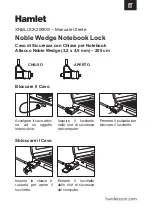
Appendix H - Glossary
160
CPU
Central Processing Unit. The integrated circuit chip that
performs the actual computing functions of the computer.
Other chips perform support functions like storing data and
controlling peripherals. Also see microprocessor. Often
measured in MHz (million hertz), which is the speed of the
processor.
CRT
Cathode Ray Tube. Another name is external monitor.
DIN
Deutsch Industrie Norm. A round multi-pin connector,
generally used to connect the keyboard and mouse to the
system.
Dip Switches
Small bank of switches built onto a circuit board or adapter
card. The DIP (Dual In-Line Package) switch settings control
various hardware options.
DMA
Direct Memory Access. A facility of some architectures which
allows a peripheral to read and write memory without
intervention by the CPU. DMA is a limited form of bus
mastering.
DOS
Disk Operating System. Operating system software which
allows the user and whatever application programs are
installed to communicate with the computer hardware. The
notebook is supplied with the MS-DOS Operating System.
DRAM
Dynamic Random Access Memory. Dynamic random access
memory (DRAM) is the most common kind of random access
memory for personal computers and workstations. DRAM is
dynamic in that, unlike static RAM, it needs to have its
storage cells refreshed or given a new electronic charge
every few milliseconds.
DSTN
Double Super-Twisted Nematic or Dual-Scan Twisted
Nematic. DSTN displays utilize dual-scan, passive matrix
screen technology. The contrast ratio can go as high as 30-
to-1, and glare resistance (washing out) is improved over
earlier DSTN screens. But refresh rate is slower than with
active matrix, or Thin Film Transistor (TFT), technology
displays, which means DSTN is less desirable for motion
video or animation. Supertwist refers to a technique for
improving LCD display screens by twisting light rays. In
addition to normal supertwist displays, there also exist double
supertwist and triple supertwist displays. In general, the more
twists, the higher the contrast. Dual-Scan refers to the
process of refreshing the screen twice as fast as
conventional passive matrix displays. Dual-Scan displays are
not as sharp or bright as active-matrix displays, but they
consume less power.
ECP
Enhanced Communication Port [Microsoft]. Also referred to
as extended capabilities port. Improves I/O performance for
LPT ports, IRQs and/or DMA settings.
EPP
Enhanced Parallel Port. A parallel port standard that supports
data-transfer rates of up to 500 Kbps compared to 150 Kbps
for the standard parallel interface.
EEPROM
Electrically Erasable Programmable Read Only Memory.
Used to store modifiable BIOS code. It retains its contents for
10 years even with no power at all. For PCI bus machines,
EEPROM will allow you to easily upgrade as the plug and
play features are standardized.
Firewire
Officially called IEEE 1394, firewire is a new, very fast
external bus standard that supports data transfer rates of up
to 400 Mbps (400 million bits per second). A single firewire
port can be used to connect up to 63 external devices. In
addition to its high speed, firewire also supports isochronous
Summary of Contents for TransPort NX
Page 10: ...10 ...
Page 18: ...18 ...
Page 42: ...42 ...
Page 52: ...52 ...
Page 60: ...60 ...
Page 128: ...128 ...
Page 134: ...134 ...
Page 150: ...150 ...
Page 152: ...152 ...
Page 156: ...156 ...
Page 170: ...Index 170 Z Zoomed Video 29 ZV 29 Zoomed Video Port 158 ZV Port 164 ZV Port 158 ...











































